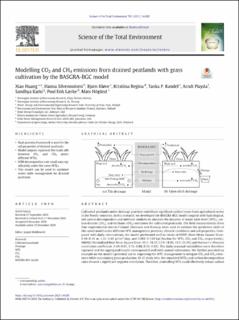| dc.contributor.author | Huang, Xiao | |
| dc.contributor.author | Silvennoinen, Hanna Marika | |
| dc.contributor.author | Kløve, Bjørn | |
| dc.contributor.author | Regina, Kristiina | |
| dc.contributor.author | Kandel, Tanka P. | |
| dc.contributor.author | Piayda, Arndt | |
| dc.contributor.author | Karki, Sandhya | |
| dc.contributor.author | Lærke, Poul Erik | |
| dc.contributor.author | Höglind, Mats | |
| dc.date.accessioned | 2021-06-22T13:38:58Z | |
| dc.date.available | 2021-06-22T13:38:58Z | |
| dc.date.created | 2021-01-02T11:44:18Z | |
| dc.date.issued | 2021-04-15 | |
| dc.identifier.citation | Huang, X., Silvennoinen, H. M., Kløve, B., Regina, K., Kandel, T. P., Piayda, A., Karki, S., Lærke, P. E., & Höglind, M. (2021). Modelling CO2 and CH4 emissions from drained peatlands with grass cultivation by the BASGRA-BGC model. Science of the Total Environment, 765, 16 | en_US |
| dc.identifier.issn | 0048-9697 | |
| dc.identifier.uri | https://hdl.handle.net/11250/2760694 | |
| dc.description.abstract | Cultivated peatlands under drainage practices contribute significant carbon losses from agricultural sector in the Nordic countries. In this research, we developed the BASGRA-BGC model coupled with hydrological, soil carbon decomposition and methane modules to simulate the dynamic of water table level (WTL), carbon dioxide (CO2) and methane (CH4) emissions for cultivated peatlands. The field measurements from four experimental sites in Finland, Denmark and Norway were used to validate the predictive skills of this novel model under different WTL management practices, climatic conditions and soil properties. Compared with daily observations, the model performed well in terms of RMSE (Root Mean Square Error; 0.06–0.11 m, 1.22–2.43 gC/m2/day, and 0.002–0.330 kgC/ha/day for WTL, CO2 and CH4, respectively), NRMSE (Normalized Root Mean Square Error; 10.3–18.3%, 13.0–18.6%, 15.3–21.9%) and Pearson's r (Pearson correlation coefficient; 0.60–0.91, 0.76–0.88, 0.33–0.80). The daily/seasonal variabilities were therefore captured and the aggregated results corresponded well with annual estimations. We further provided an example on the model's potential use in improving the WTL management to mitigate CO2 and CH4 emissions while maintaining grass production. At all study sites, the simulated WTLs and carbon decomposition rates showed a significant negative correlation. Therefore, controlling WTL could effectively reduce carbon losses. However, given the highly diverse carbon decomposition rates within individual WTLs, adding indi-cators (e.g. soil moisture and peat quality) would improve our capacity to assess the effectiveness of specificmitigation practices such as WTL control and rewetting. | en_US |
| dc.language.iso | eng | en_US |
| dc.publisher | Elsevier B.V. | en_US |
| dc.rights | Attribution-NonCommercial-NoDerivatives 4.0 Internasjonal | * |
| dc.rights.uri | http://creativecommons.org/licenses/by-nc-nd/4.0/deed.no | * |
| dc.subject | Palsmyr | en_US |
| dc.subject | Grasarealer | en_US |
| dc.subject | GHG emissions | en_US |
| dc.title | Modelling CO2 and CH4 emissions from drained peatlands with grass cultivation by the BASGRA-BGC model | en_US |
| dc.type | Peer reviewed | en_US |
| dc.type | Journal article | en_US |
| dc.description.version | publishedVersion | en_US |
| dc.rights.holder | © 2020 The Author(s) | en_US |
| dc.subject.nsi | VDP::Matematikk og Naturvitenskap: 400::Zoologiske og botaniske fag: 480::Økologi: 488 | en_US |
| dc.source.volume | 765 | en_US |
| dc.source.journal | Science of the Total Environment | en_US |
| dc.identifier.doi | 10.1016/j.scitotenv.2020.144385 | |
| dc.identifier.cristin | 1864290 | |
| dc.relation.project | Norges forskningsråd: 281109 | en_US |
| dc.source.articlenumber | 144385 | en_US |
| cristin.ispublished | true | |
| cristin.fulltext | original | |
| cristin.qualitycode | 2 | |

